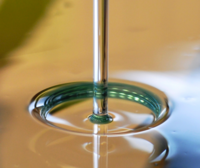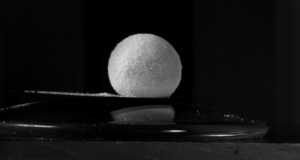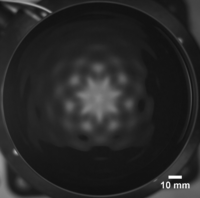Fluids and interfaces
Hydraulic jumps / jets

When a liquid stream falls on a horizontal plate as from a water tap in a kitchen sink, it flows in a thin rapid layer away from the point of impingement. Due to the radial spreading of the flow and friction from the plate, we expect the liquid layer to gradually lose its speed, but in fact it does so in an unexpectedly abrupt way. The depth of the liquid layer increases by an order of magnitude within an extremely narrow, circular locus, called the circular hydraulic jump.
Since Leonardo Da Vinci, this phenomenon has attracted the attention of physicists and has given birth to passionate debates. We have contributed on different aspects of this thematic:
- By showing that the Froude number at the exit of the jump is constant, we have provided a robust scaling law able to predict the jump radius given the physical parameters of the system. [HJ1]
- We have examined in depth the role of the surface tension in the circular hydraulic jump. [HJ2,HJ3]
- Finally, we have shown that the circular hydraulic jump can oscillate following cavity resonance modes. [HJ4]
[HJ1] A. Duchesne, L. Lebon & L. Limat, Constant Froude number in a circular hydraulic jump and its implication on the jump radius selection, Europhys. Lett. 107, 54002 (2014).
[HJ2] A. Duchesne, A. Andersen & T. Bohr, Surface tension and the origin of the circular hydraulic jump in a thin liquid film, Phys. Rev. Fluids 4, 084001 (2019).
[HJ3] A. Duchesne & L. Limat, Circular hydraulic jumps : where does surface tension matter?, J. Fluid Mech. (Rapids), 937, R2 (2022).
[HJ4] A. Goerlinger, M. Baudoin, F. Zouestiagh & A. Duchesne, Oscillations and cavity modes in the circular hydraulic jump, Phys. Rev. Lett. 131, 194001 (2023).
Particle covered interfaces

The presence of partially wetting microparticles at the interface between two fluids can drastically modify the mechanical properties of these interfaces and lead to some unexpected behaviors. First, we demonstrated that pushing a liquid finger inside a tube covered with particles enables the tailored synthesis of cylindrical bubbles encapsulated in a monolayer of particles (so-called “armoured bubbles”) [PC1, PC2], which remain stable even when extracted from the tube. Second, we revisited the Saffman-Taylor instability when particles are adsorbed by the interface between the two fluids [PC3]. Finally, we demonstrated that ultra-long lasting (> 1 year) air bubbles resisting drainage, evaporation and nuclei induced bursting can be simply synthesized by replacing surfactants by microparticles and water by a hygroscopic liquid [PC4].
[PC1] A. Riaud, J.L. Thomas, E. Charron, A. Bussonière, O. Bou Matar and M. Baudoin, Anisotropic swirling surface acoustic waves synthesis by inverse filter for on-chip generation of acoustical vortices, Phys. Rev. Appl., 4: 034004 (2015)
[PC2] G. Prabhudesai, I. Bihi, F. Zoueshtiagh, J. Jose, M. Baudoin, Nonspherical armoured bubbles vibration, Soft Matter, 13: 3879 (2017)
[PC3] I. Bihi, M. Baudoin, J.E. Butler, C.Faille F. Zoueshtiagh*, Inverse Saffman-Taylor experiments with particles lead to capillary driven fingering instabilities, Phys. Rev. Lett., 117: 034501 (2016)
[PC4] A. Roux, A. Duchesne, M. Baudoin, Everlasting bubbles and liquid films resisting drainage, evaporation and nuclei-induced bursting, Phys. Rev. Fluid (Letter), 7: L011601 (2022)
Leidenfrost

When a liquid drop is deposited on a surface (liquid or solid) heated well beyond the boiling temperature of the drop, the drop will experience Leidenfrost levitation. This mechanism is due to the presence of a thin vapor layer that will separate, and then isolate, the liquid drop from the hot substrate. As a consequence , the evaporation time will dramatically increase and the friction between the drop and the substrate will almost disappear.
In our team we are actively working on two configurations:
- When the substrate is in fact a liquid. As the substrate is now infinitely smooth and deformable it has for effect to lower the temperature for which the Leidenfrost effect occur [LF1] (see Figure © Florence Cavagnon). We have also investigated the flow created in the hot bath by the drop. And we have seen that changing the liquid in the drop may inverse the flow in the bath [LF2].
- We also investigate the impact of a jet on a hot plate.
[LF1] L. Maquet, B. Sobac, B. Darbois-Texier, A. Duchesne, M. Brandenbourger, A. Rednikov, P. Colinet & S. Dorbolo, Leidenfrost drops on a heated liquid pool, Phys. Rev. Fluids 1, 053902 (2016).
[LF2] B. Sobac, L. Maquet, A. Duchesne, H. Machrafi, A. Rednikov, P. Dauby, P. Colinet, & S. Dorbolo, Self-induced Flows enhance the levitation of Leidenfrost drops on liquid baths, Phys. Rev. Fluids 5, 062701(R) (2020).
Faraday instability

The flat interface of a liquid bath contained in a vertically vibrating vessel may be parametrically excited, leading to the generation of standing surface waves. Here, the Faraday instability is revisited by analyzing the effect of a rigid body rotation of the liquid bath on parametrically forced surface waves. The main feature of this new configuration is the parabolic geometry of the fluid interface, onto which surface waves establish at the threshold of instability. Experimental evidences show that this geometry does not affect the wave dispersion relation of the standing waves as compared to the classical flat configuration. However, rotation significantly lowers the instability threshold. Linear stability analysis and Floquet theory are applied to the governing equations. By neglecting Coriolis effect, we demonstrate the weak dependence of the wave dispersion relation with rotation, and identify the origin of the decrease of the Faraday threshold with rotation; this decrease is the signature of the shrinking of the viscous dissipation rate of the surface wave due to the parabolic geometry of the interface.
Soap films

Soap films may be made of soap and water, as well as other ingredients. The key here is the presence of a surfactant such as soap, SDS or TTAB, which will lower the surface tension of the solution. When we stretch a film on a frame, the surfactant molecules aggregate at the interfaces, encapsulating a thin layer of water. Our team focuses on observing these films under several angles :
- We can pierce the film with a jet of water, soap solution or even oil, without breaking it. In the case of a water jet, we observe a vortex around it, which we are currently studying.
- We investigate the attraction force between two ferrous particules deposited on a film thanks to Helmholtz coils generating a magnetic field on it.
- When depositing droplets (of water or oil) on a film, we create a potential well for other droplets to navigate in. We are caracterizing this well and studying the orbiting dynamics of two droplets interacting on a film before merging.
- If two droplets are in close range from each other on a soap film, they stretch with respect to their relative masses. We are currently caracterizing this stretch, which appears just before two orbiting droplets merge.
Liquid plug dynamics

Liquid plugs play a fundamental role both in chemical engineering processes and in medecine where they can form naturally in the lung due to the instability of mucus lining of patients suffering from cystic fibrosis or pulmonary obstructive diseases. Our team has studied the dynamics and rupture of these liquid plugs in simplified geometries. Our work includes experimental observation and theoretical modeling of cascades of plug ruptures in simple lining and microfluidic tree structures [LP1,LP2] mimicking the last generations of the lung tree, as well as response of liquid plugs to cyclic forcing [LP3,LP4]. More recently we showed that pushing a liquid plug at high speed in a cylindrical tube leads to the formation of a long droplet surrounded by a thin air film, a reverse situation compared to Bretherton bubbles [LP5].
[LP1] M. Baudoin, Y. Song, P. Manneville, C.N. Baroud, Airways reopening through catastrophic events in a hierarchical network, Proc. Nat. Ac. Sci., 110: 859-864 (2013).
[LP2] J.C. Magniez, M. Baudoin, C. Liu, F. Zoueshtiagh, Dynamics of liquid plugs in prewetted capillary tubes: from acceleration and rupture to deceleration and airway obstruction, Soft Matter, 12: 8710-8717(2016)
[LP3] S. Signé Mamba, J.C. Magniez, F. Zoueshtiagh, M. Baudoin, Dynamics of a liquid plug in a capillary tube under cyclic forcing: memory effects and airway reopening, J. Fluid. Mech.: 838: 165-191 (2018)
[LP4] S. Signé Mamba, F. Zoueshtiagh, M. Baudoin, Pressure-driven dynamics of liquid plugs in rectangular micro-channels: influence of the transition between static and dynamic film deposition regimes, Int. J. Multiph. Flow, 113: 343-357 (2019)
[LP5] P. Favreau, A. Duchesne, F. Zoueshtiagh, M. Baudoin, The motion of long levitating drops in tubes in an anti-Bretherton configuration, Phys. Rev. Lett., 125: 194501 (2020)
